If you’ve been paying attention to tech news in 2025, you’ve noticed something remarkable: the conversation has shifted. We’re no longer just talking about chatbots or AI assistants that answer our questions. We’re witnessing the emergence of something far more transformative AI agents that can think, plan, and act autonomously on our behalf. Let’s dive deeper about what are AI Agent!
The numbers tell an extraordinary story. According to a recent PwC survey, 88% of executives plan to increase their AI budgets this year specifically because of agentic AI. The global AI agent market, valued at $5.1 billion in 2024, is projected to explode to $47.1 billion by 2030. That’s a compound annual growth rate of 44.8%—and we’re right at the beginning of this revolution.
But what exactly are AI agents, and why is everyone—from Fortune 500 CEOs to solo entrepreneurs—suddenly talking about them? Let’s dive into this fascinating world together.
Table of Contents
What Exactly Are AI Agents?
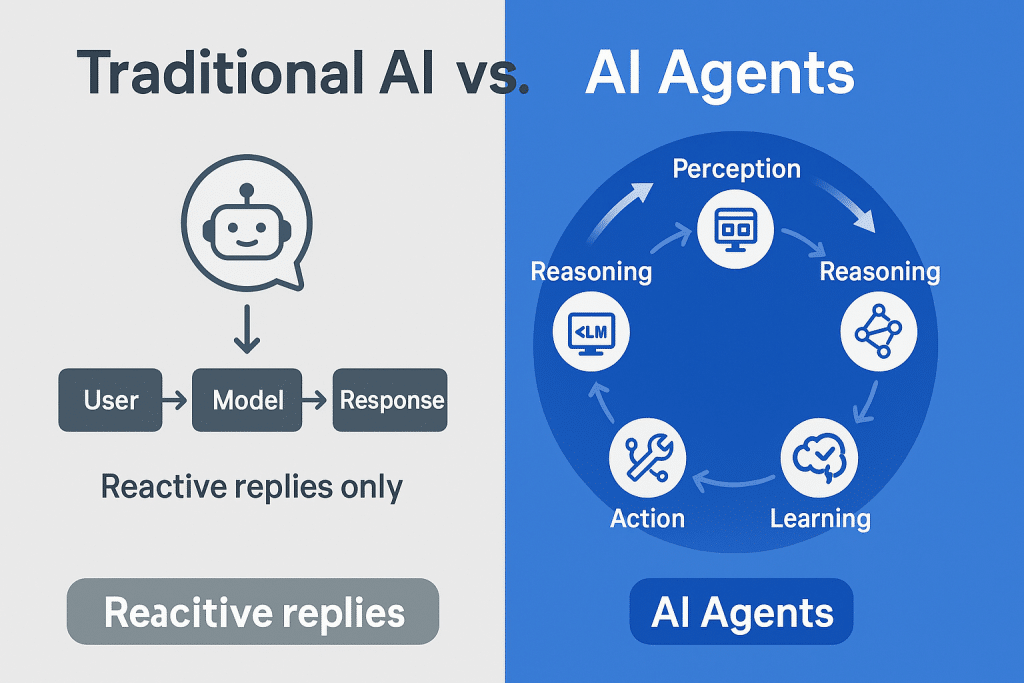
Here’s where we need to draw a clear line. When we talk about AI agents, we’re not describing your typical chatbot or AI assistant. Let’s break down the distinction:
Traditional AI/Chatbots: These systems respond to our prompts. We ask a question, they give an answer. We request an action, they perform it. They’re reactive and require constant human direction.
AI Agents: These are autonomous software entities that can perceive their environment, make decisions, plan multi-step workflows, take actions, and continuously learn—all with minimal human oversight. They don’t just respond; they act.
Think of it this way: if traditional AI is like a very smart calculator that waits for our input, AI agents are more like hiring a skilled assistant who understands your goals and figures out the best way to achieve them independently.
The Core Components That Make Agents “Intelligent”
AI agents possess several key capabilities that set them apart:
Perception: They can observe and understand their environment—whether that’s reading emails, monitoring system performance, or analyzing market data.
Reasoning: Using large language models (LLMs), they can process information logically and make informed decisions about what to do next.
Planning: They break down complex objectives into manageable steps and create strategies to achieve goals.
Memory: They remember previous interactions, learn from outcomes, and use that knowledge to improve future performance.
Autonomy: This is the game-changer—they can execute multi-step tasks without asking permission at every stage.
Tool Use: They can interact with various systems, APIs, databases, and applications to get things done.
The Different Types of AI Agents We’re Seeing in 2025
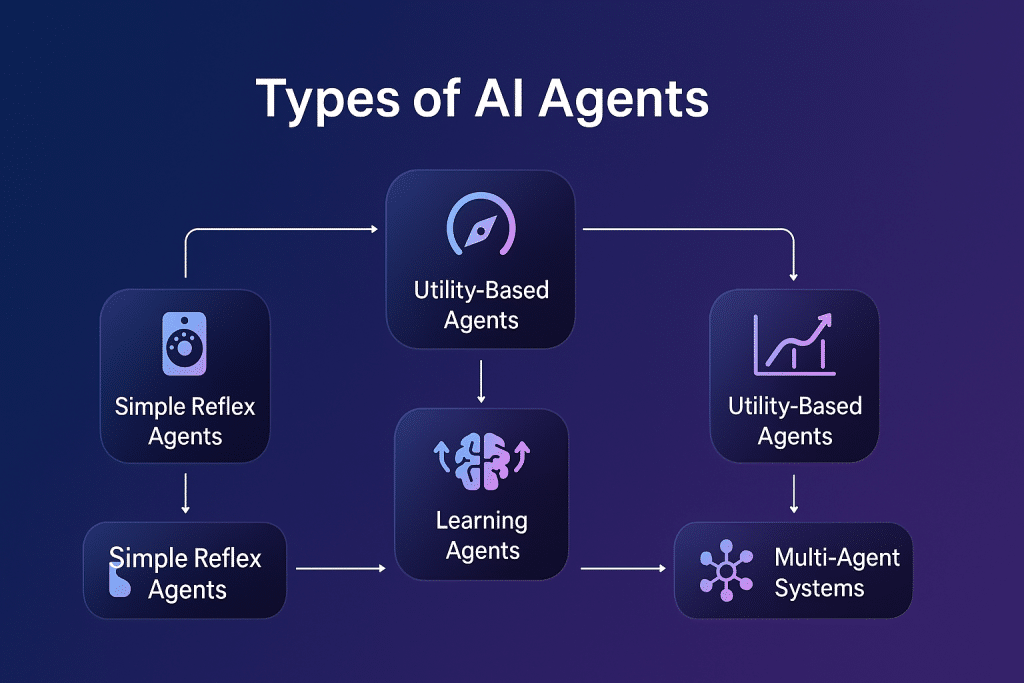
Not all AI agents are created equal. We’re seeing a spectrum of capabilities:
Simple Reflex Agents
These operate on “if-then” rules—if temperature drops, turn on heating. They’re fast and predictable but lack memory and can’t adapt to new situations.
Goal-Based Agents
These agents evaluate future outcomes to achieve specific objectives. Think of navigation systems that consider traffic, distance, and fuel to get you to your destination efficiently.
Utility-Based Agents
These optimize across multiple factors—balancing cost, speed, safety, and user satisfaction. E-commerce recommendation engines fall into this category, weighing what will generate sales while keeping customers happy.
Learning Agents
The most sophisticated category. These agents learn from experience, adapt their behavior, and improve performance over time. Autonomous vehicles continuously learning from real-world driving data are prime examples.
Multi-Agent Systems
Here’s where it gets really interesting. These are teams of AI agents working together, each specialized in different tasks but collaborating toward common goals. It’s like having an entire digital workforce.
Why 2025 Became “The Year of AI Agents”
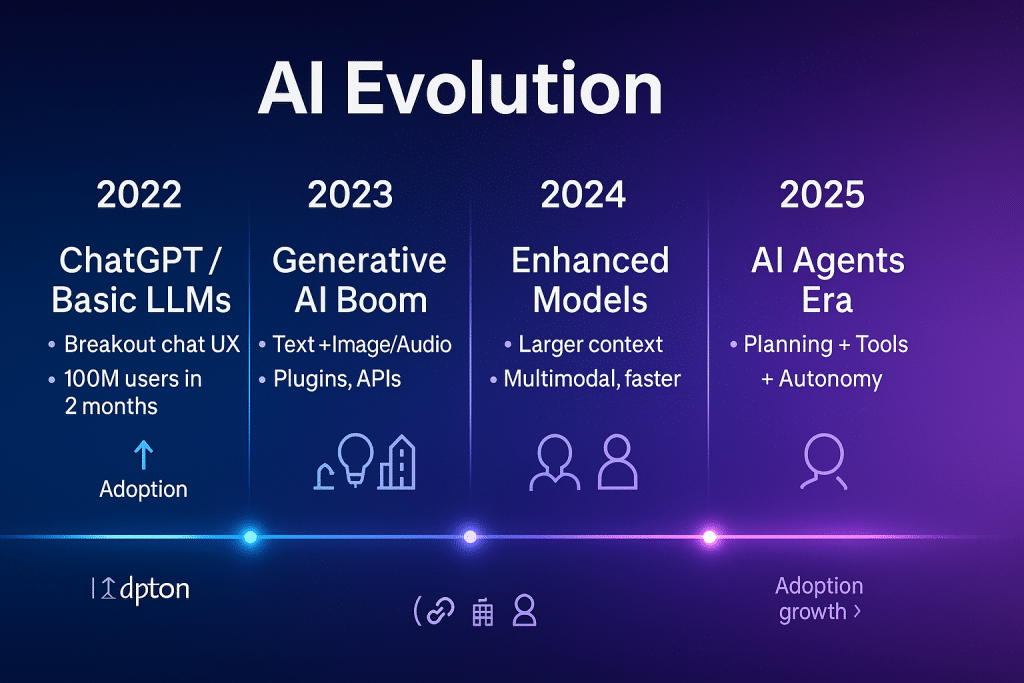
Several factors converged to make 2025 the breakthrough year for AI agents:
Advanced Reasoning Capabilities
Models like OpenAI’s o1 series and Claude with extended thinking can now perform complex, multi-step reasoning similar to human problem-solving. This cognitive leap is fundamental to agent capabilities.
Cost-Effective Foundation Models
AI has become more accessible. We’re seeing powerful models that are both cheaper to run and more efficient, making agent deployment economically viable for businesses of all sizes.
Improved Reliability
While hallucinations and errors still occur, techniques like retrieval-augmented generation (RAG), better training methods, and robust error-handling have made agents reliable enough for production use.
Developer Tools and Frameworks
The emergence of sophisticated frameworks—LangChain, AutoGen, CrewAI, n8n—has made building and deploying agents dramatically easier than even a year ago.
Real ROI Evidence
Early adopters are reporting tangible results. Companies implementing AI agents have seen efficiency improvements of up to 50% in functions like customer service, sales, and operations. When the business case becomes clear, adoption accelerates rapidly.
Where We’re Seeing AI Agents Transform Industries
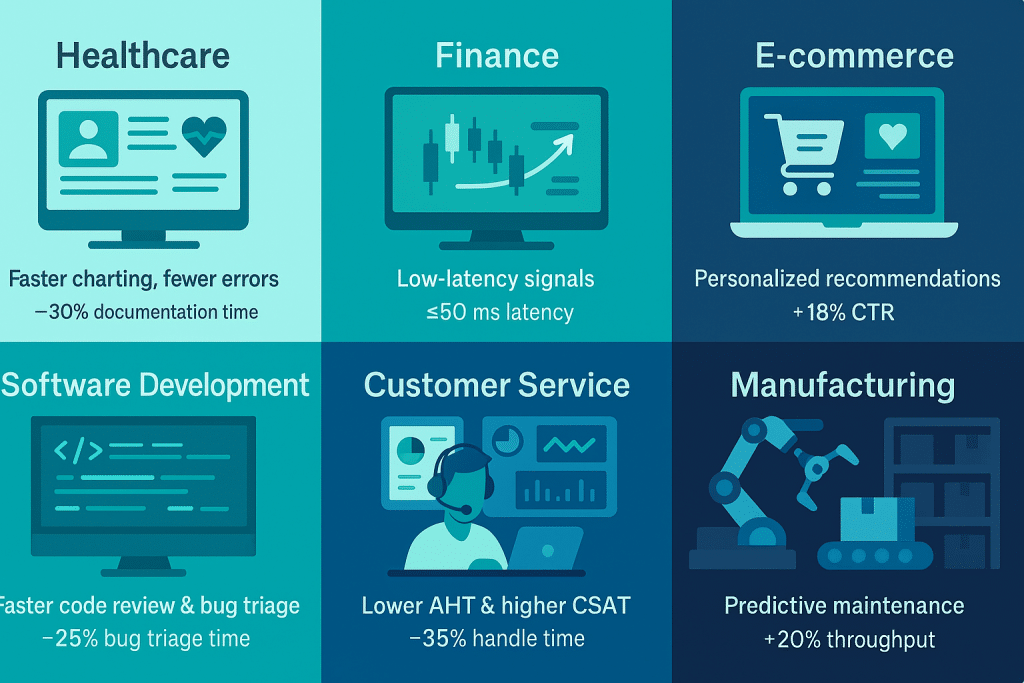
The applications are both broad and deep. Let’s explore where agents are making the biggest impact:
Software Development Revolution
AI coding agents like GitHub Copilot, Cursor, Windsurf, and Claude Code are fundamentally changing how we write software. These agents don’t just suggest code—they:
- Autonomously write entire functions based on natural language descriptions
- Debug code by analyzing error patterns and applying fixes
- Refactor legacy codebases for better performance
- Generate test suites and documentation automatically
- Execute multi-file changes across complex projects
We’re seeing developers report productivity increases of 40-60% when working with sophisticated coding agents.
Customer Service Transformation
Gone are the days of frustrating phone trees. Modern customer service agents can:
- Understand complex queries across multiple channels
- Access customer history and predict needs
- Resolve issues without human escalation in 70%+ of cases
- Learn from each interaction to improve responses
- Handle multiple customers simultaneously in different languages
E-commerce and Personalization
Agents are revolutionizing online shopping through:
- Dynamic pricing that adjusts in real-time based on demand, inventory, and competitor pricing
- Hyper-personalized product recommendations that consider individual preferences, browsing behavior, and contextual factors
- Automated inventory management and supply chain optimization
- Conversational shopping assistants that guide users through complex purchase decisions
Healthcare Innovation
In medical settings, agents are being deployed for:
- Patient monitoring systems that analyze vitals and alert staff to concerning patterns
- Medical record analysis that identifies potential drug interactions or relevant patient history
- Treatment recommendation systems that process vast medical literature to suggest evidence-based approaches
- Administrative automation that handles scheduling, billing, and insurance processing
Financial Services
The finance sector is seeing agents excel at:
- Automated trading systems that analyze market conditions and execute strategies
- Fraud detection that identifies suspicious patterns in real-time
- Risk assessment that evaluates loan applications or investment portfolios
- Regulatory compliance monitoring across transactions
Enterprise Operations
In corporate environments, agents are streamlining:
- Email management and intelligent routing
- Meeting scheduling across multiple calendars and time zones
- Report generation from multiple data sources
- Workflow automation across departments
- Document analysis and contract review
The Real Power: Multi-Agent Systems
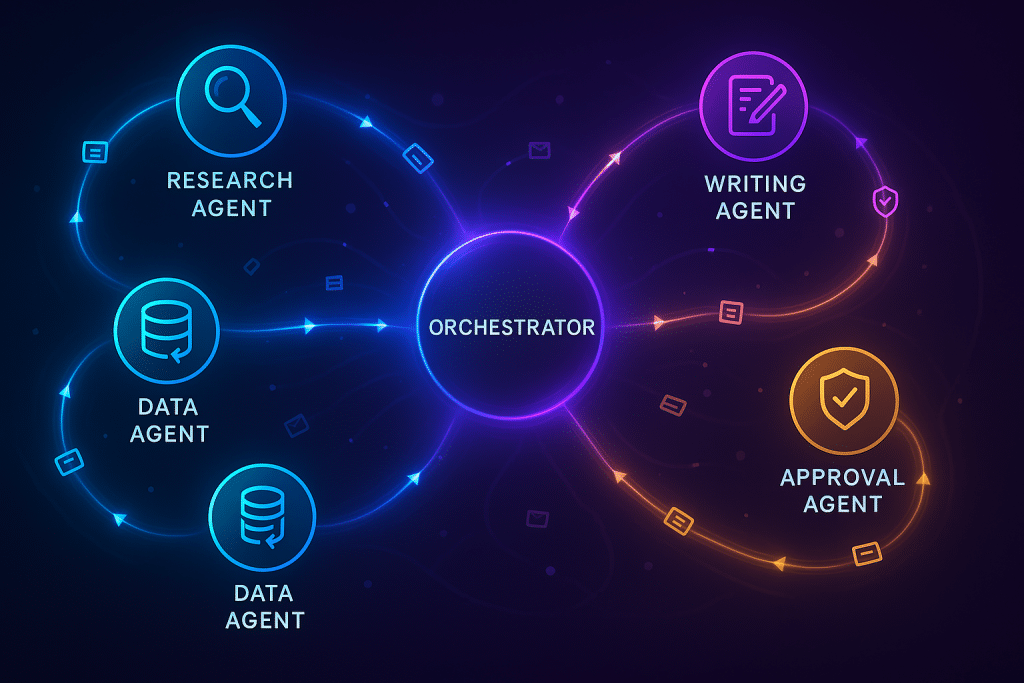
Here’s where we’re seeing the most exciting developments. Instead of a single agent trying to do everything, we’re building teams of specialized agents that collaborate.
Imagine a hospitality company (this is a real example) where:
- A customer service agent fields initial inquiries
- A booking agent checks availability and processes reservations
- A pricing agent optimizes rates based on demand
- A customer experience agent monitors satisfaction and proactively addresses issues
- An analytics agent tracks performance across all interactions
These agents don’t work in isolation—they communicate, share information, and coordinate actions seamlessly. The result? Faster service, lower costs, and better customer experiences.
IBM’s research shows that 99% of developers building AI applications are exploring or developing multi-agent systems. This isn’t the future; it’s happening right now.
The Spectrum of Autonomy: Where Are We Really?
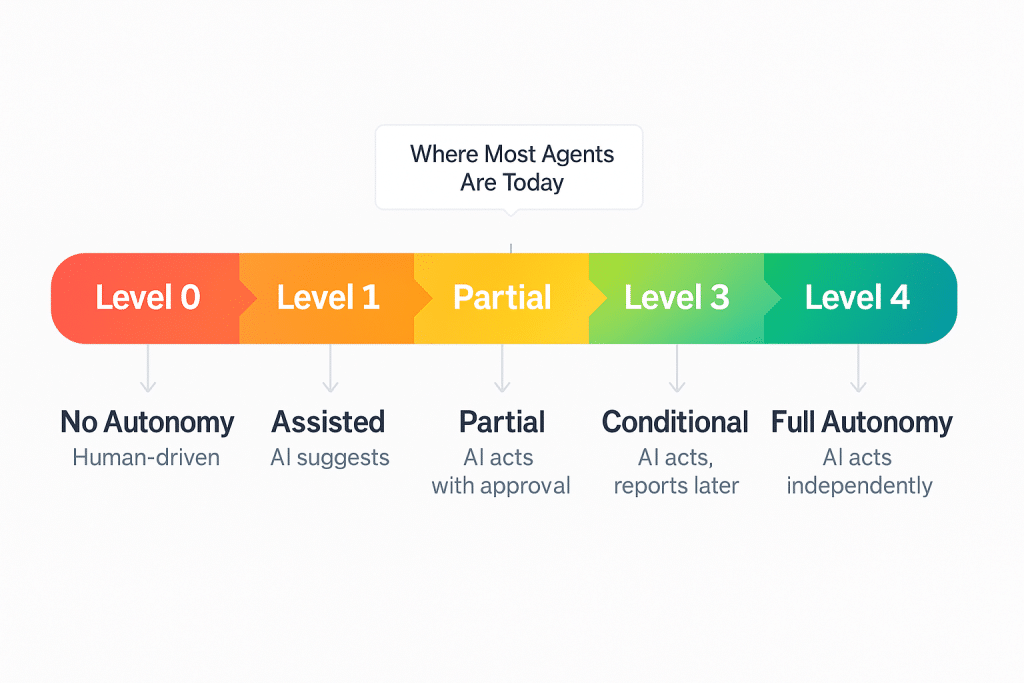
We need to be honest about where we are on the autonomy spectrum. Following a framework similar to autonomous vehicle levels:
Level 0-1: Human-driven with AI assistance (where we were in 2023)
Level 2: Partial autonomy—agents can complete tasks but require approval for important actions (where most implementations are today)
Level 3: Conditional autonomy—agents act independently within defined boundaries and report back
Level 4: Full autonomy—agents operate independently across domains, adapt to outcomes, and even create their own tools
Most of 2025’s agents operate at Level 2-3. They’re tremendously useful, but we’re not yet at the “set it and forget it” stage for mission-critical applications. And honestly, that’s probably a good thing.
The Challenges We Need to Talk About
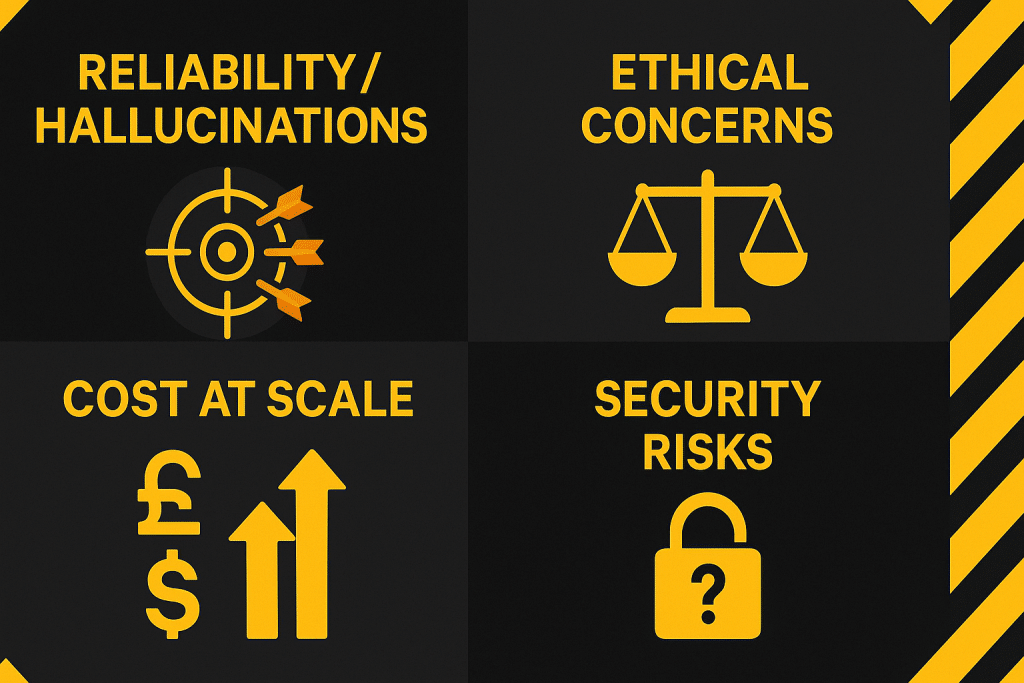
Let’s not sugarcoat this—deploying AI agents comes with real challenges:
Reliability and Hallucinations
LLMs can generate false information confidently. When you chain multiple agent actions together, errors can compound. A single hallucination early in a workflow can cascade into serious problems.
What we’re doing about it: Human-in-the-loop checkpoints, confidence scoring, multi-agent validation, and extensive testing before production deployment.
Performance and Cost
State-of-the-art models that power the most capable agents (GPT-4, Claude Sonnet, etc.) are expensive when used at scale. Multi-agent systems making hundreds of API calls per task can quickly become cost-prohibitive.
What we’re doing about it: Hybrid approaches using smaller, specialized models for routine tasks and reserving powerful models for complex decisions. Tool optimization to reduce unnecessary calls.
Security and Privacy
Agents accessing multiple systems and data sources create new attack surfaces. What if an agent is tricked into exposing sensitive information or taking harmful actions?
What we’re doing about it: Strict access controls, sandbox environments for testing, audit trails of all agent actions, and robust authentication protocols.
The “Black Box” Problem
Understanding why an agent made a specific decision can be challenging. For regulated industries or high-stakes decisions, explainability is crucial.
What we’re doing about it: Developing explainability frameworks, decision logging, and human oversight for critical actions.
What Experts Are Saying: Hype vs. Reality
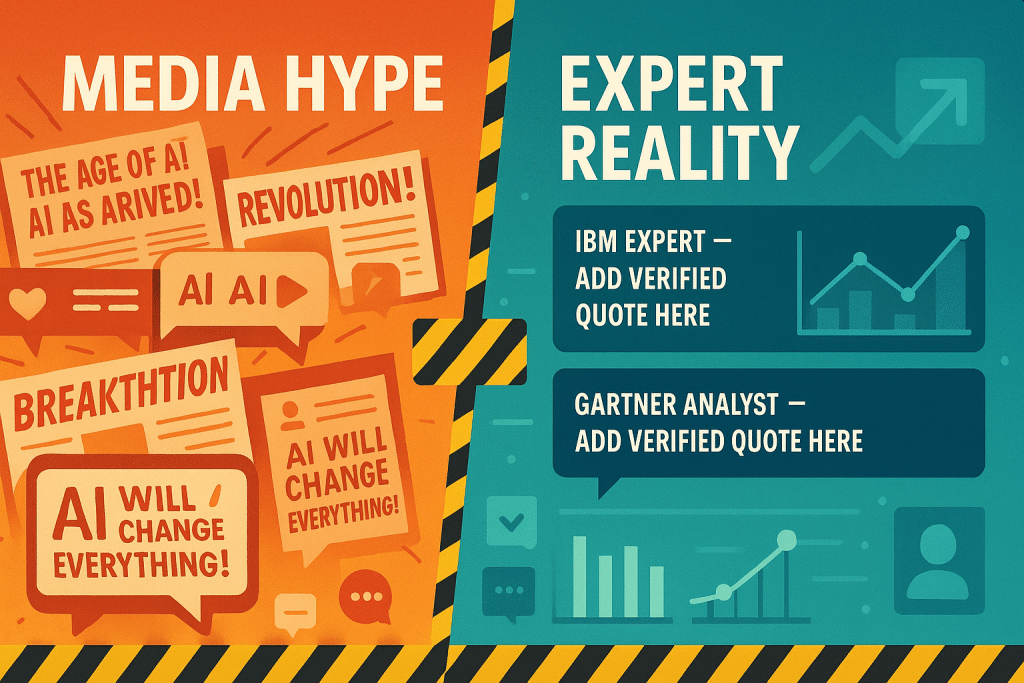
Marina Danilevsky, Senior Research Scientist at IBM, offers this grounded perspective: “It depends on what you say an agent is, what you think an agent is going to accomplish, and what kind of value you think it will bring. It’s quite a statement to make when we haven’t even yet figured out ROI on LLM technology more generally.”
But Maryam Ashoori, Director of Product Management at IBM watsonx.ai, notes real momentum: “IBM and Morning Consult surveyed 1,000 developers building AI applications for enterprise, and 99% said they are exploring or developing AI agents. So yes, 2025 is going to be the year of the agent.”
The consensus among experts? We’re at an inflection point. Agents are real, valuable, and improving rapidly—but we should approach them with informed optimism rather than uncritical enthusiasm.
The Market Opportunity We’re Witnessing
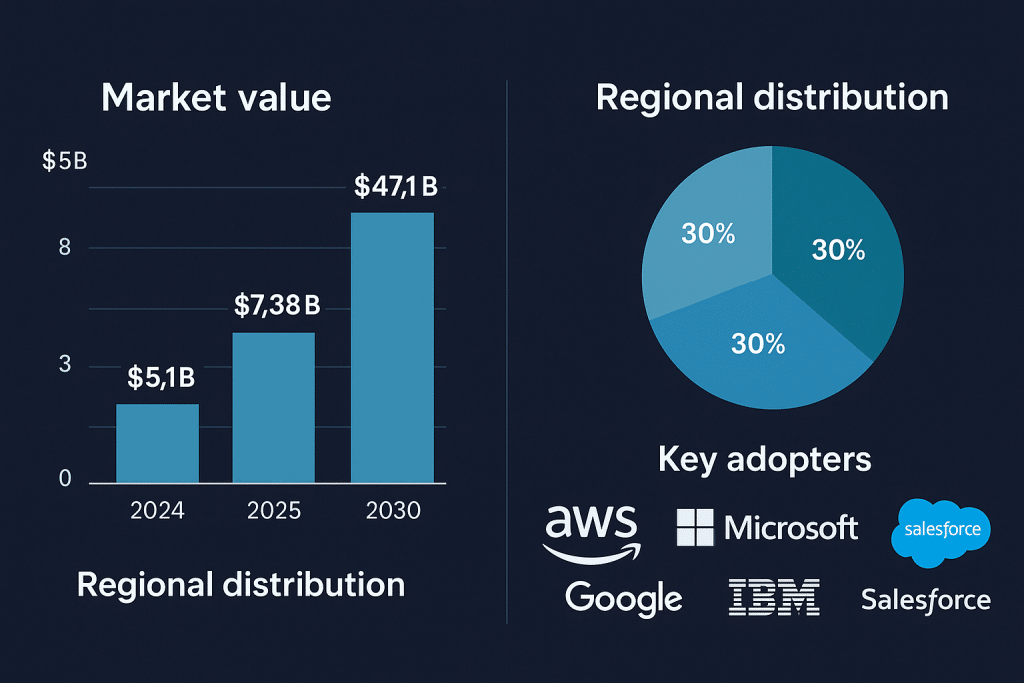
The economics are compelling:
- Global AI agent market: $5.1 billion (2024) → $47.1 billion (2030)
- CAGR: 44.8% through 2032
- North America currently leads with 40% market share
- Enterprise adoption: 79% of companies are already deploying agents in some capacity
- ROI: Early adopters report $3.70 return for every $1 invested in AI
Major tech companies are going all-in:
- AWS created an entirely new business unit focused on AI agents
- Microsoft embedded agent capabilities throughout Microsoft 365 and Dynamics
- Google launched Project Mariner for web automation
- Salesforce introduced AgentForce for enterprise workflows
- Oracle deployed Miracle Agents across their Fusion Cloud suite
When tech giants make these kinds of organizational bets, it’s a signal that we’re past the experimental phase.
Building Responsibly: The Human Element
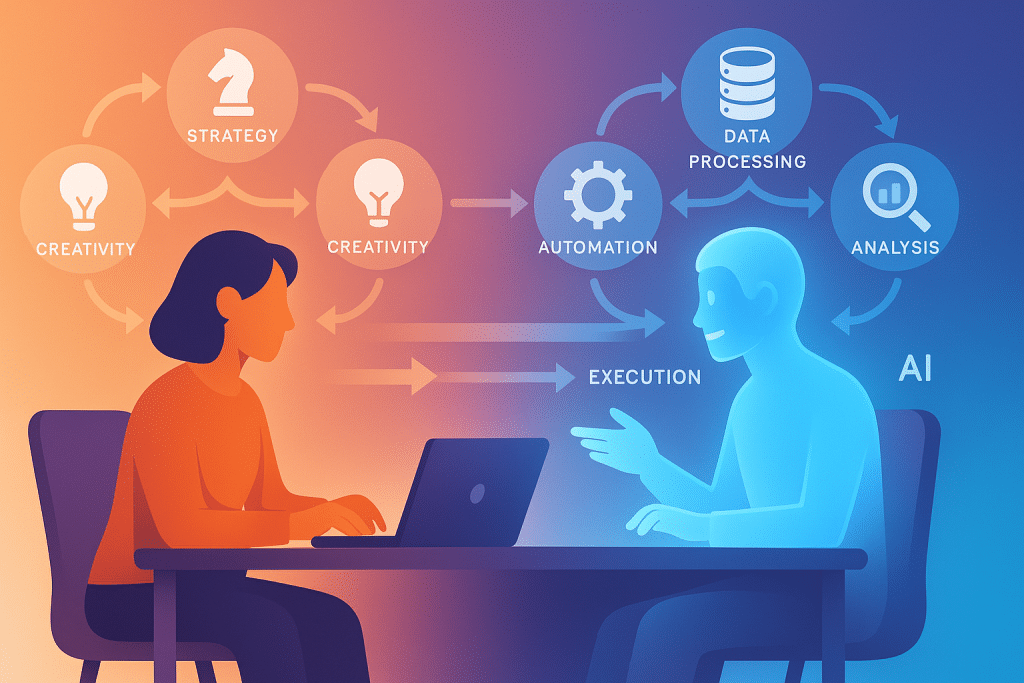
Here’s something crucial we need to emphasize: the goal isn’t to replace humans—it’s to amplify human capability.
The most successful implementations we’re seeing in 2025 follow a pattern:
Agents handle: Repetitive tasks, data gathering, initial analysis, routine decision-making, monitoring and alerts, documentation and reporting.
Humans handle: Strategic planning, creative problem-solving, ethical judgments, relationship building, complex negotiations, oversight and course correction.
Think of agents as junior team members. They can do valuable work and learn from experience, but they still benefit from experienced human guidance and judgment.
Getting Started: Practical Steps for 2025
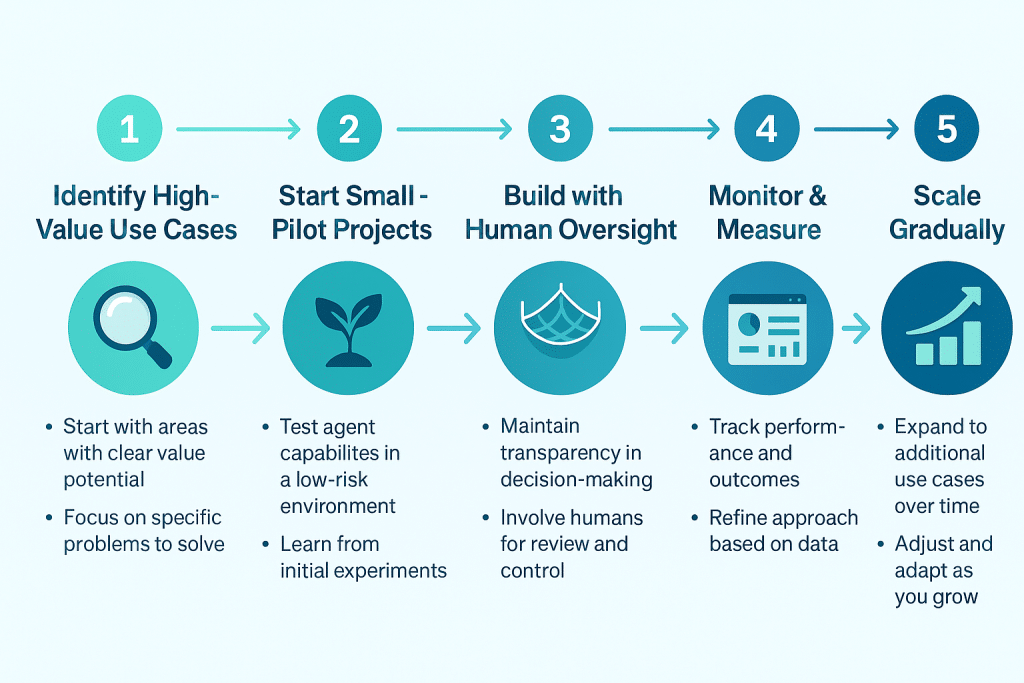
If you’re considering implementing AI agents, here’s a pragmatic approach:
1. Identify High-Value, Low-Risk Starting Points
Look for tasks that are:
- Time-consuming and repetitive
- Well-defined with clear success criteria
- Non-critical to core business operations initially
- Data-rich with accessible information sources
Examples: Email categorization, meeting scheduling, report generation, data entry, initial customer inquiry handling.
2. Choose the Right Tools for Your Needs
The agent ecosystem offers options for different technical capabilities:
No-Code/Low-Code: n8n, Zapier, Make.com (great for business users) Developer Frameworks: LangChain, AutoGen, CrewAI (for technical teams) Enterprise Platforms: Salesforce AgentForce, Microsoft Copilot Studio, AWS Bedrock Agents (for large organizations)
3. Build with Oversight, Not Just Autonomy
Start with “human-in-the-loop” implementations where agents handle tasks but humans review before critical actions. As you build confidence, gradually expand autonomy.
4. Measure What Matters
Track metrics like:
- Time saved on specific tasks
- Error rates compared to manual processes
- User satisfaction with agent interactions
- Cost per task completion
- Speed of task completion
5. Iterate and Improve
Agents get better with use. Review edge cases, refine prompts, adjust tools, and continuously improve based on real-world performance.
The Competitive Imperative
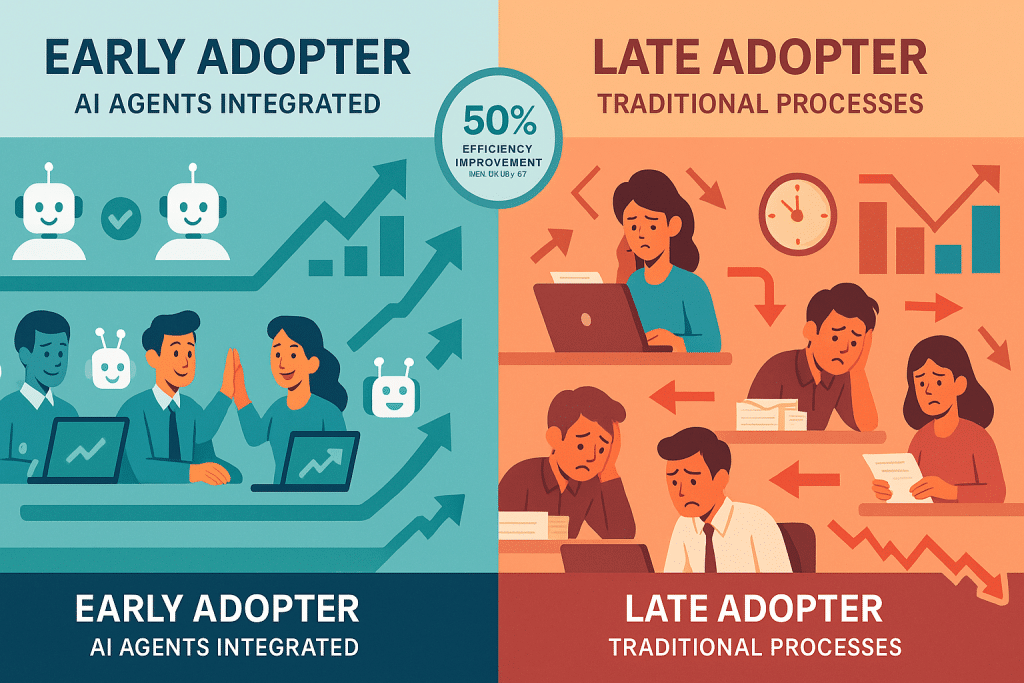
Here’s the reality we’re facing: AI agents aren’t just a neat technology upgrade—they’re becoming a competitive necessity.
Companies implementing agents are reporting:
- 50% efficiency improvements in key functions
- 40-60% productivity increases in software development
- 70%+ customer query resolution without human escalation
- Significant cost reductions in operations
Organizations that move quickly to understand and deploy agents gain advantages that will be hard for competitors to catch up with. We’re seeing a pattern similar to previous technology shifts—early movers build capabilities, processes, and competitive moats that create lasting advantages.
What’s Next: The Road Ahead
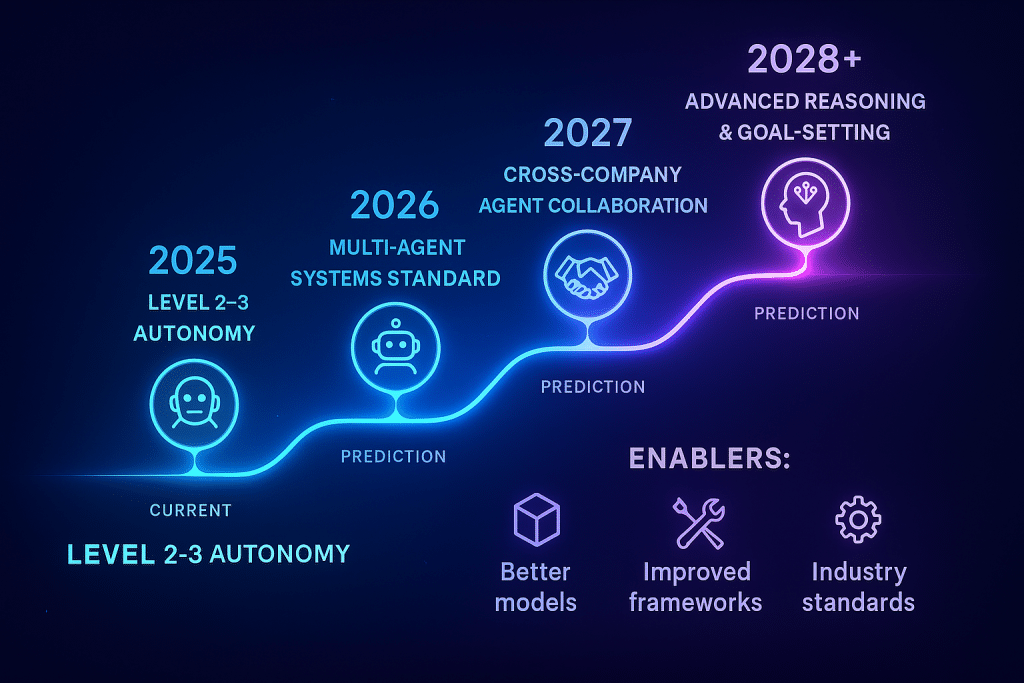
Looking forward, we’re tracking several key trends:
Increasing Autonomy
We’ll see more Level 3 and Level 4 agents capable of operating independently for extended periods with minimal oversight.
Cross-Platform Collaboration
Agents from different companies and platforms will begin communicating and collaborating, creating networked intelligence across organizational boundaries.
Industry Specialization
We’ll see purpose-built agents for specific industries—legal AI agents trained on case law, medical agents with deep clinical knowledge, financial agents optimized for trading strategies.
Improved Explainability
As regulation catches up with technology, we’ll see better tools for understanding and auditing agent decision-making.
Broader Accessibility
No-code agent builders will make this technology available to non-technical users, democratizing access to autonomous AI.
Gartner predicts that by 2028, at least 15% of work decisions will be made autonomously by agentic AI, compared to 0% in 2024. That’s not gradual change—that’s transformation.
The Bottom Line: Why This Matters to All of Us
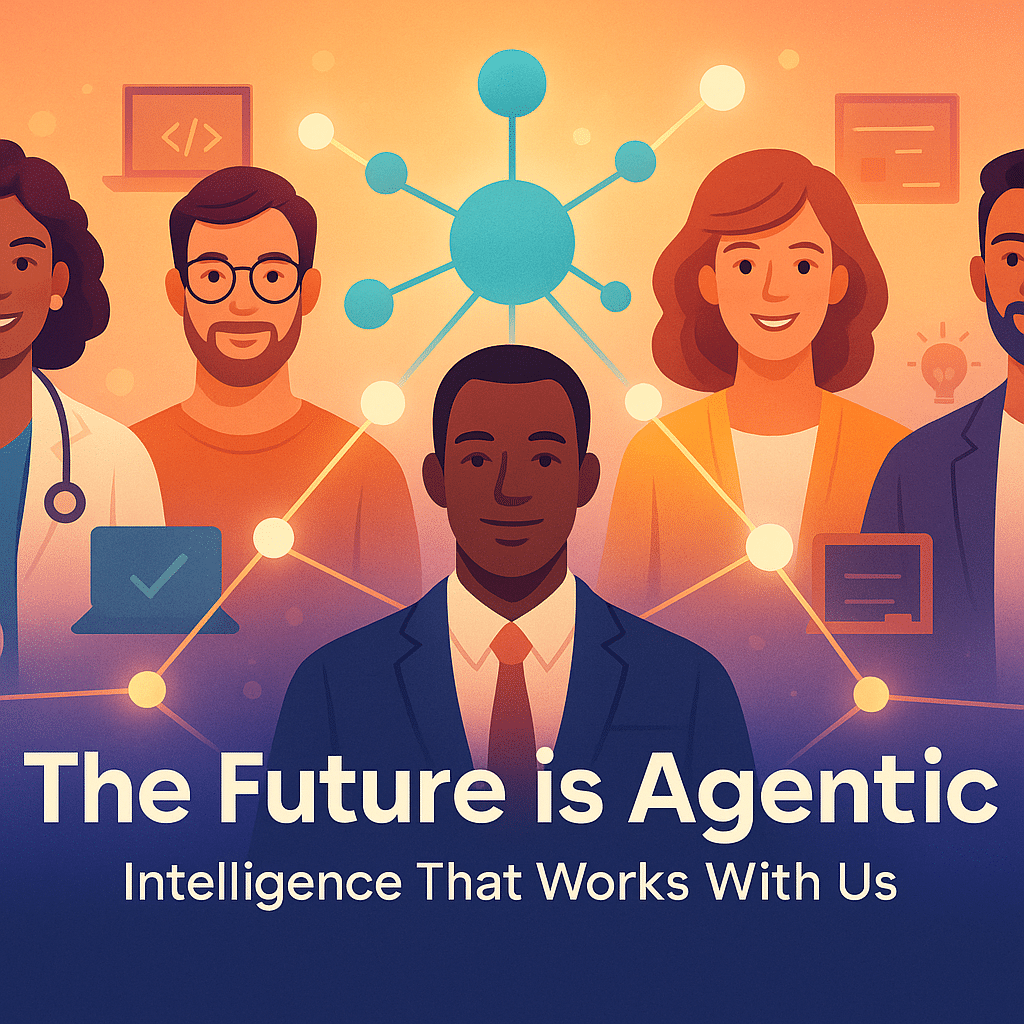
We’re at a remarkable moment in technological history. AI agents represent more than just an incremental improvement—they’re a fundamental shift in how we interact with software and how work gets done.
For the first time, we have digital systems that can genuinely understand goals, devise strategies, take actions, and learn from outcomes with minimal supervision. This isn’t science fiction; it’s happening in enterprises around the world right now in 2025.
But here’s what makes this revolution different from previous hype cycles: it’s grounded in measurable value. Companies are seeing real ROI, real efficiency gains, and real competitive advantages. When 88% of executives plan to increase AI budgets and 79% are already deploying agents, we’re past the experimental phase.
The conversation in 2025 isn’t whether AI agents will transform how we work—it’s how quickly we can harness their potential responsibly and effectively. Organizations that figure this out first will have significant advantages. Those that wait too long risk being left behind.
We’re not just witnessing the year of AI agents. We’re living through the beginning of a new era in human-computer collaboration—one where intelligent systems work alongside us, amplifying our capabilities and freeing us to focus on what humans do best: strategy, creativity, relationships, and judgment.
The question isn’t whether AI agents will impact your industry or organization. The question is: how will you prepare for and leverage this transformation?
The age of AI agents has arrived. The only question that matters now is: what will we build with them?
Implementation & Technical
How much does it cost to implement AI agents?
Costs vary widely depending on your approach. No-code platforms like n8n or Zapier can start as low as $20-100/month for basic agent workflows. Enterprise platforms like Microsoft Copilot Studio or AWS Bedrock Agents typically run $10-50 per user per month, with additional costs for API calls to underlying LLMs. Custom-built agents using frameworks like LangChain have development costs (developer time) plus ongoing API costs. The good news: early adopters report $3.70 return for every $1 invested, so ROI often justifies the investment quickly.
What technical skills do I need to build AI agents?
It depends on your approach. No-code/low-code platforms (n8n, Zapier, Make.com) allow business users with no programming experience to build functional agents through visual interfaces. For more sophisticated custom agents, you’ll want developers familiar with Python, API integration, and LLM concepts. Enterprise platforms often provide middle-ground solutions with drag-and-drop builders plus the option to add custom code when needed. Many organizations start with no-code tools for simple use cases and bring in technical teams for more complex implementations.
Which AI models are best for building agents?
The “best” model depends on your specific needs and budget. For high-complexity tasks requiring advanced reasoning, models like GPT-4, Claude Sonnet, or Gemini Advanced work well. For routine tasks, smaller models like GPT-3.5, Claude Haiku, or open-source options like Llama 3.1 offer good performance at lower costs. Many successful implementations use a hybrid approach—smaller models for routine tasks and larger models for complex reasoning. The key is matching model capability to task complexity.
How long does it take to implement an AI agent?
Timeline varies by complexity. A simple agent handling a single workflow (like email categorization) can be built and tested in days using no-code platforms. More complex multi-agent systems handling cross-functional workflows might take 2-3 months from planning through pilot deployment. Most experts recommend starting with a focused pilot (4-6 weeks), measuring results, then gradually expanding. The fastest path to value is identifying a high-impact, well-defined use case and building that first rather than trying to boil the ocean.
Can AI agents integrate with our existing software systems?
Yes, that’s one of their key strengths. Modern AI agents can integrate with most business software through APIs, webhooks, and direct integrations. Popular enterprise platforms (Salesforce, Microsoft 365, Google Workspace, Slack, etc.) have robust integration options. Custom internal systems might require API development, but most agent frameworks support standard protocols like REST APIs, GraphQL, and database connections. Before implementation, inventory your key systems and verify integration options.
Security & Reliability
How secure are AI agents? Can they be hacked?
Security is a critical consideration. AI agents do create new attack surfaces because they access multiple systems and data sources. However, proper implementation includes several safeguards: strict access controls (agents only access what they need), authentication protocols, sandbox environments for testing, audit trails of all actions, and encryption for data in transit and at rest. The security level ultimately depends on your implementation. Treat agent deployment like hiring a new employee—grant minimal necessary permissions and increase access gradually as trust is established.
What about AI hallucinations? Won’t agents make mistakes?
Yes, AI hallucinations remain a challenge. LLMs can generate false information confidently, and when you chain multiple agent actions together, errors can compound. However, several mitigation strategies help: implementing human-in-the-loop checkpoints for critical decisions, using confidence scoring to flag uncertain responses, multi-agent validation where multiple agents verify important information, extensive testing before production deployment, and starting with low-risk use cases. Most successful implementations treat agents like junior employees—capable but requiring oversight on important matters.
How do we ensure AI agents comply with regulations like GDPR or HIPAA?
Compliance requires thoughtful implementation. Key strategies include: data minimization (agents only access necessary data), encryption and secure storage, audit trails of all data access and processing, user consent mechanisms where required, and data retention policies aligned with regulations. For highly regulated industries (healthcare, finance), start with on-premise or private cloud deployments where you maintain full control over data. Many enterprise agent platforms offer compliance features specifically for regulated industries. Consult with your legal and compliance teams before deploying agents handling sensitive data.
What happens if an AI agent makes a costly mistake?
This is why most organizations implement agents with appropriate oversight levels. For critical decisions, use “human-in-the-loop” approaches where agents propose actions but humans approve before execution. For less critical tasks, “human-on-the-loop” monitoring allows agents to act but humans review outcomes. Include rollback mechanisms for reversible actions, implement spending limits or approval thresholds, maintain detailed logs for troubleshooting, and establish clear escalation paths. Start with low-stakes applications to build confidence before deploying agents in high-risk scenarios.
Business & ROI
What’s the typical ROI timeline for AI agents?
Most organizations implementing AI agents see initial value within 2-3 months and meaningful ROI within 6-12 months. Research shows that businesses achieve returns of $3.70 for every $1 invested in AI, with some early adopters reporting 50% efficiency improvements in key functions. The fastest ROI comes from targeting high-volume, repetitive tasks where time savings translate directly to cost reduction or revenue generation. Quick wins build momentum and funding for more ambitious agent deployments.
Which business functions benefit most from AI agents?
Based on 2025 data, the biggest wins are in: Customer service (70%+ query resolution without human escalation), Software development (40-60% productivity increases), Sales operations (automated lead enrichment and follow-up), Finance (automated reconciliation, reporting, and fraud detection), HR (recruiting screening, onboarding, employee support), and Operations (supply chain optimization, inventory management). The common thread is high-volume, process-driven work with clear success criteria.
How do we measure AI agents performance?
Key metrics to track include: Efficiency metrics (time saved, tasks completed per hour, cost per task), Quality metrics (error rate compared to manual processes, user satisfaction scores), Business metrics (revenue impact, cost reduction, customer satisfaction improvement), Adoption metrics (percentage of employees using agents, frequency of use), and Reliability metrics (uptime, successful task completion rate, escalation frequency). Establish baseline measurements before implementation so you can demonstrate concrete improvements.
What if our competitors are implementing AI agents faster than us?
This is a valid concern. We’re seeing a pattern similar to previous technology shifts—early movers build capabilities and competitive advantages that become hard to catch. Organizations implementing agents today are reporting significant efficiency gains that translate to cost advantages and faster time-to-market. However, rushing into poor implementation is worse than waiting to do it right. The key is to start now with focused pilots in high-value areas, learn quickly, and scale what works. Even starting small puts you ahead of organizations still in the “wait and see” phase.
Where will AI agents be in 5 years?
Experts predict several key trends: Increased autonomy (more Level 3 and Level 4 agents operating independently), Cross-platform collaboration (agents from different companies working together), Industry specialization (purpose-built agents for legal, medical, financial sectors), Improved explainability (better tools for understanding agent decisions), and Broader accessibility (no-code builders making agents available to non-technical users). Gartner predicts that by 2028, at least 15% of work decisions will be made autonomously by agentic AI, compared to 0% in 2024.
Should we build our own agents or buy pre-built solutions?
This depends on your needs, resources, and strategic goals. Buy pre-built when: you have common use cases (customer service, scheduling, email management), you need fast deployment, you lack in-house AI expertise, or you want proven, supported solutions. Build custom when: you have unique workflows that differentiate your business, you have sensitive data requiring custom security, you have technical teams capable of building and maintaining agents, or you need specific integrations unavailable in commercial products. Many organizations use a hybrid approach—commercial solutions for common needs, custom builds for competitive differentiators.
How do we prepare our workforce for working with AI agents?
Successful adoption requires change management: Education (help employees understand what agents can and can’t do), Training (teach teams how to work effectively with agents), Involvement (include frontline workers in identifying agent use cases), Communication (be transparent about goals and address job security concerns), and Iteration (gather feedback and continuously improve agent performance). Frame agents as tools that enhance human capability rather than replacements. Organizations with strong change management see faster adoption and better results.
What’s the biggest mistake companies make when implementing AI agents?
The most common mistake is trying to do too much too fast. Organizations get excited about the potential and try to deploy agents across multiple functions simultaneously without proper testing or oversight. This leads to quality issues, user frustration, and failed initiatives that set back adoption. The smarter approach: start with a focused pilot in one high-value area, measure results rigorously, learn from challenges, iterate and improve, then expand gradually to other areas. Build capability and confidence before scaling.
Getting Started
How do I convince my leadership to invest in AI agents?
Focus on business outcomes, not technology features. Present a concrete use case with estimated ROI: time savings, cost reduction, or revenue impact. Share industry examples of similar companies achieving results. Start with a small pilot that requires minimal investment but delivers visible value. Emphasize competitive risk—79% of companies are already deploying agents. Frame it as a strategic capability, not just a technology project. Offer to start with a low-risk proof of concept that delivers results in 4-6 weeks.
What’s the first step to implementing AI agents in our organization?
Start by identifying high-value, low-risk opportunities. Look for tasks that are time-consuming and repetitive, well-defined with clear success criteria, non-critical to core business operations initially, and data-rich with accessible information sources. Examples include email categorization, meeting scheduling, report generation, or initial customer inquiry handling. Once you identify a good use case, assess your technical options (no-code platforms vs. custom development), define success metrics, build a small pilot, and measure results. Quick wins build momentum for larger deployments.
Do we need a dedicated AI team to implement agents?
Not necessarily, especially for starting out. Many organizations successfully implement initial agents using no-code platforms with existing business analysts or operations teams. As you scale, having dedicated resources helps—whether that’s a small AI/automation team or working with external consultants. The key roles you’ll eventually need include: someone who understands business processes and can identify opportunities, technical skills for integration and customization, project management to coordinate implementation, and change management to drive adoption. Start small with existing resources and build capability over time.
Still Have Questions?
The world of AI agents is evolving rapidly. If you have specific questions about implementing AI agents in your organization or want to explore how agents could transform your specific workflows, we encourage you to start with small experiments and learn by doing. The technology is more accessible than ever, and the competitive advantages are real.
FAQ
What is an AI agent?
An AI agent is software that observes its environment (data, user input, tools), decides what to do, and takes actions toward a goal with some level of autonomy, often learning and improving over time. Google Cloud+1
How do AI agents work in practice?
Most modern AI agents follow a loop: understand a goal or input, break it into tasks, choose tools or APIs, execute actions, then evaluate the result and iterate. Frameworks and platforms handle this perception–decision–action loop under the hood. Jotform+1
What are the main types of AI agents?
Common categories include reactive agents, rule-based agents, learning agents, utility-based agents, and fully autonomous or multi-agent systems. In practice, many real-world agents mix these approaches. aliz.ai+1
How are AI agents different from chatbots or basic automation?
A simple chatbot usually answers messages one-by-one, while an AI agent can plan multi-step workflows, call external tools or apps, and pursue a goal until it’s done—more like a digital coworker than a single-response bot. Zapier+1
What are some real-world examples of AI agents?
Examples include customer-support agents that resolve tickets across multiple tools, research agents that gather and summarize sources, sales agents that update CRMs and send follow-ups, and operations agents that move data between systems automatically. Engini+1
Where are AI agents used most today?
Adoption is fastest in customer support, marketing and sales operations, finance and reporting, IT automation, e-commerce, and internal knowledge assistants—places where repetitive digital work and fragmented tools are a big problem. Engini+1
How can I build or deploy my own AI agent?
You can use platforms like ChatGPT Agent / Agent Builder, Vertex AI Agent Builder, or no-code automation tools that now support agents (e.g., Zapier Agents) to define goals, wire up tools, and publish agents without starting from scratch. Zapier+3Aihika.com+3OpenAI+3
Do I need coding skills to use AI agents?
Coding helps for complex, custom agents, but many 2025 platforms provide visual builders and templates. Non-developers can still create useful agents by configuring steps, connecting apps, and writing clear instructions. Aihika.com+1
What are the main risks or limitations of AI agents?
Key risks include data privacy and security, hallucinated or incorrect actions, biased decisions, compliance issues, and unexpected costs. Guardrails, access controls, human-in-the-loop review, and clear scopes are essential. IBM+2Apideck+2
How will AI agents change work and jobs in the next few years?
Most research and expert commentary suggests agents will first automate routine digital tasks and augment knowledge workers, rather than instantly replacing whole roles—shifting many jobs toward supervising, editing, and designing agent workflows. Engini+2Salesforce+2
Last Updated: October 2025

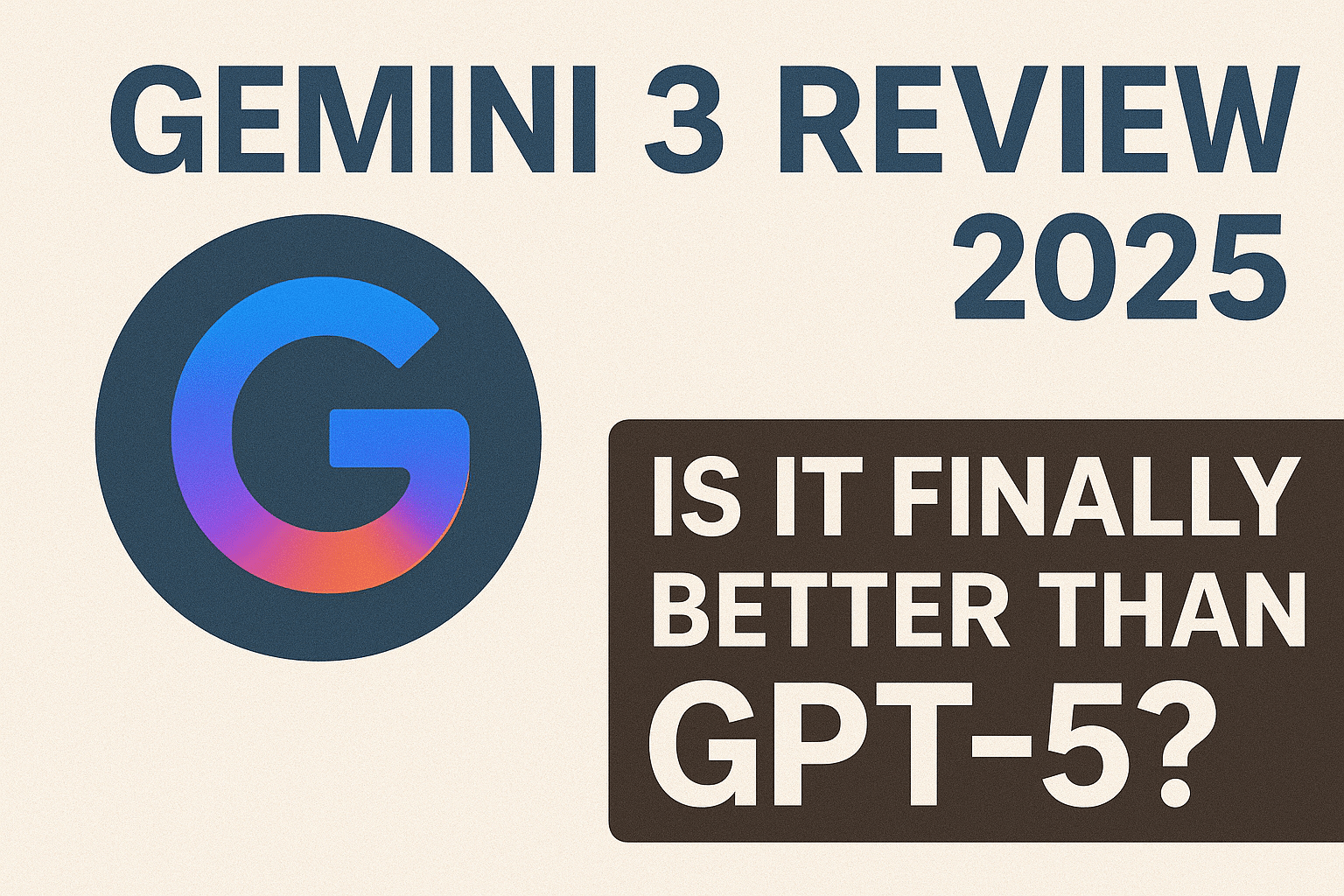
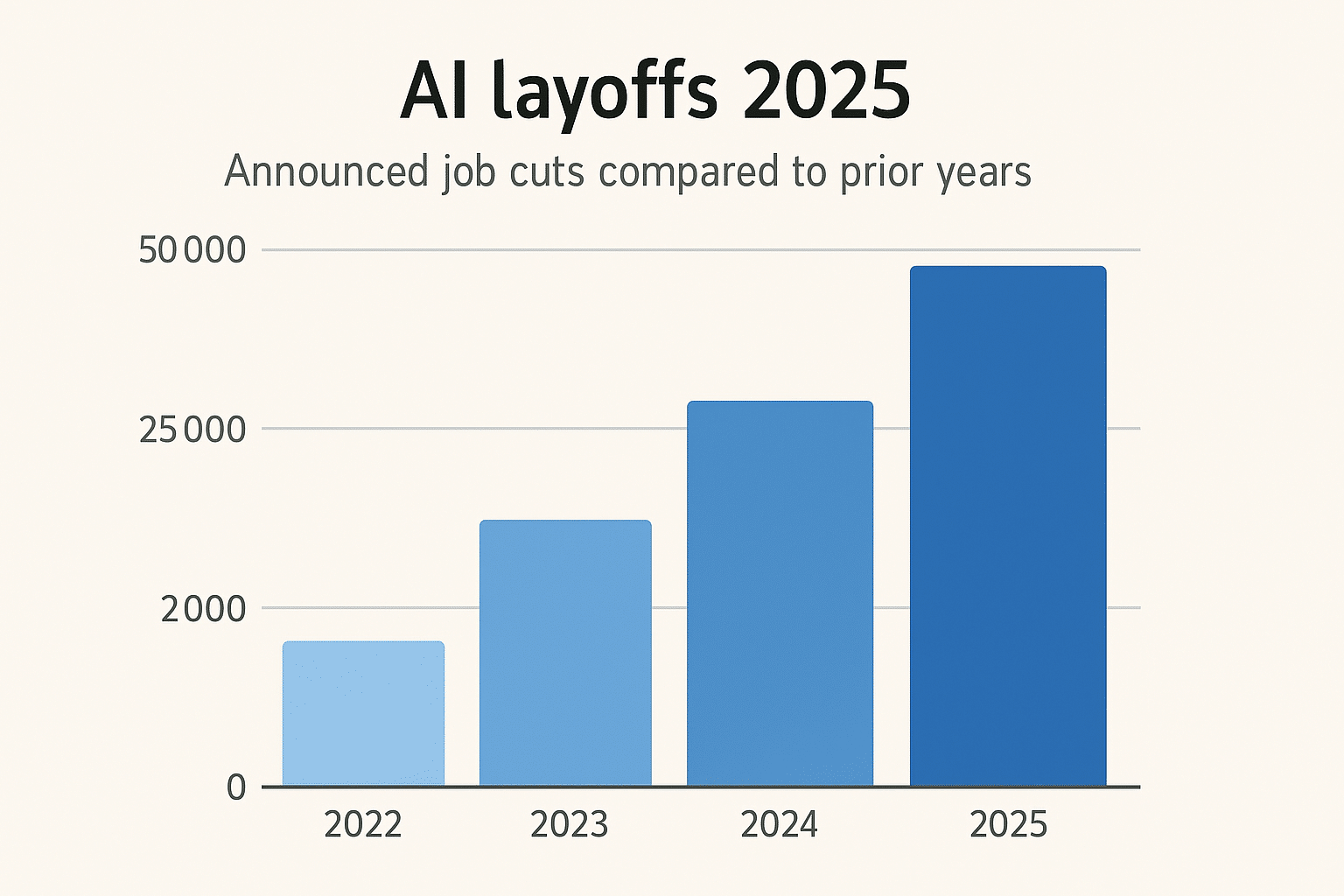






Leave a Reply